One-Step Synthesis of Environmentally Friendly Superhydrophilic and Superhydrophobic Sponges for Oil/Water Separation
Abstract
:1. Introduction
2. Materials and Methods
2.1. Materials
2.2. Preparation of the Hydrophilic CC Rods
2.3. Preparation of the Hydrophobic CC Rods
2.4. Preparation of the MFS/CC-DKGM
2.5. Preparation of the MFS/CC-PDMS
2.6. Oil/Water Separation by the Absorption Process
2.7. Selective Oil/Water Separation by the Filtration Process
2.8. Characterization
3. Results and Discussion
3.1. Synthesis of Two Types of Environmentally Friendly Absorbents
3.2. Surface Morphology of MFS/CC-DKGM and MFS/CC-PDMS
3.3. Characterization of MFS/CC-DKGM and MFS/CC-PDMS
3.4. Wettability Characteristics of MFS/CC-DKGM and MFS/CC-PDMS
3.5. Oil and Water Absorption Performances of MFS/CC-DKGM and MFS/CC-PDMS
3.6. The Chemical, Thermal, and Mechanical Stabilities of MFS/CC-DKGM and MFS/CC-PDMS
3.7. The Possibility of Leakage of CC Rods from MFS/CC-DKGM and MFS/CC-PDMS after Use
4. Conclusions
Author Contributions
Acknowledgments
Conflicts of Interest
References
- Xu, Z.; Zhao, Y.; Wang, H.; Wang, X.; Lin, T. A Superamphiphobic coating with an ammonia-triggered transition to superhydrophilic and superoleophobic for oil–water separation. Angew. Chem. Int. Ed. 2015, 54, 4527–4530. [Google Scholar] [CrossRef] [PubMed]
- Zhang, W.; Shi, Z.; Zhang, F.; Liu, X.; Jin, J.; Jiang, L. Superhydrophobic and superoleophilic PVDF membranes for effective separation of water-in-oil emulsions with high flux. Adv. Mater. 2013, 25, 2071–2076. [Google Scholar] [CrossRef]
- Pan, Q.; Wang, M.; Wang, H. Separating small amount of water and hydrophobic solvents by novel superhydrophobic copper meshes. Appl. Surf. Sci. 2008, 254, 6002–6006. [Google Scholar] [CrossRef]
- Wang, Y.; Shi, Y.; Pan, L.; Yang, M.; Peng, L.; Zong, S.; Shi, Y.; Yu, G. Multifunctional superhydrophobic surfaces templated from innately microstructured hydrogel matrix. Nano Lett. 2014, 14, 4803–4809. [Google Scholar] [CrossRef]
- Wang, C.; Yao, T.; Wu, J.; Ma, C.; Gan, Z.; Wang, Z.; Cheng, Y. Facile approach in fabricating superhydrophobic and superoleophilic surface for water and oil mixture separation. ACS Appl. Mater. Interface 2009, 1, 2613–2617. [Google Scholar] [CrossRef]
- Crick, C.R.; Gibbins, J.A.; Parkin, I.P. Superhydrophobic polymer-coated copper-mesh; membranes for highly efficient oil–water separation. J. Mater. Chem. A 2013, 1, 5943–5948. [Google Scholar] [CrossRef]
- Li, L.; Hu, T.; Sun, H.; Zhang, J.; Wang, A. Pressure-sensitive and conductive carbon aerogels from poplars catkins for selective oil absorption and oil/water separation. ACS Appl. Mater. Interface 2017, 9, 18001–18007. [Google Scholar] [CrossRef] [PubMed]
- Li, L.; Li, B.; Sun, H.; Zhang, J. Compressible and conductive carbon aerogels from waste paper with exceptional performance for oil/water separation. J. Mater. Chem. A 2017, 5, 14858–14864. [Google Scholar] [CrossRef]
- Zhang, J.; Li, B.; Li, L.; Wang, A. Ultralight, compressible and multifunctional carbon aerogels based on natural tubular cellulose. J. Mater. Chem. A 2016, 4, 2069–2074. [Google Scholar]
- Zang, D.; Wu, C.; Zhu, R.; Zhang, W.; Yu, X.; Zhang, Y. Porous copper surfaces with improved superhydrophobicity under oil and their application in oil separation and capture from water. Chem. Commun. 2013, 49, 8410–8412. [Google Scholar] [CrossRef] [PubMed]
- Chu, Z.; Feng, Y.; Seeger, S. Oil/water separation with selective superantiwetting/superwetting surface materials. Angew. Chem. Int. Ed. 2015, 54, 2328–2338. [Google Scholar] [CrossRef]
- Xue, Z.; Wang, S.; Lin, L.; Chen, L.; Liu, M.; Feng, L.; Jiang, L. A novel superhydrophilic and underwater superoleophobic hydrogel-coated mesh for oil/water separation. Adv. Mater. 2011, 23, 4270–4273. [Google Scholar] [CrossRef]
- Zhang, F.; Zhang, W.B.; Shi, Z.; Wang, D.; Jin, J.; Jiang, L. Nanowire-haired inorganic membranes with superhydrophilicity and underwater ultralow adhesive superoleophobicity for high-efficiency oil/water separation. Adv. Mater. 2013, 25, 4192–4198. [Google Scholar] [CrossRef]
- Zhang, W.; Zhu, Y.; Liu, X.; Wang, D.; Li, J.; Jiang, L.; Jin, J. Salt-induced fabrication of superhydrophilic and underwater superoleophobic PAA-g-PVDF membranes for effective separation of oil-in-water emulsions. Angew. Chem. Int. Ed. 2014, 53, 856–860. [Google Scholar] [CrossRef]
- Kaang, B.K.; Han, N.; Jang, W.R.; Koo, H.Y.; Lee, Y.B.; Choi, W.S. Crossover magnetic amphiprotic catalysts for oil/water separation, the purification of aqueous and non-aqueous pollutants, and organic synthesis. Chem. Eng. J. 2018, 331, 290–299. [Google Scholar] [CrossRef]
- Islam, M.S.; Choi, W.S.; Kim, S.H.; Han, O.H.; Lee, H.J. Inorganic micelles (hydrophilic core@ amphiprotic shell) for multiple applications. Adv. Funct. Mater. 2015, 25, 6061–6070. [Google Scholar] [CrossRef]
- Boakye-Ansah, S.; Lim, Y.T.; Lee, H.J.; Choi, W.S. Structure-controllable superhydrophobic Cu meshes for effective separation of oils with different viscosities and aqueous pollutant purification. RSC Adv. 2016, 6, 17642–17650. [Google Scholar] [CrossRef]
- Lee, Y.S.; Kaang, B.K.; Han, N.; Lee, H.J.; Choi, W.S. An anti-overturn Janus sponge with excellent floating stability for simultaneous pollutant remediation and oil/water separation. J. Mater. Chem. A 2018, 6, 16371–16381. [Google Scholar] [CrossRef]
- Du, X.; You, S.; Wang, X.; Wang, Q.; Lu, J. Switchable and simultaneous oil/water separation induced by prewetting with a superamphiphilic self-cleaning mesh. Chem. Eng. J. 2017, 313, 398–403. [Google Scholar] [CrossRef]
- Gao, C.; Sun, Z.; Li, K.; Chen, Y.; Cao, Y.; Zhang, S.; Feng, L. Integrated oil separation and water purification by a double-layer TiO2-based mesh. Energy Environ. Sci. 2013, 6, 1147–1151. [Google Scholar] [CrossRef]
- Chen, Y.; Li, F.; Cao, W.; Li, T. Preparation of recyclable CdS photocatalytic and superhydrophobic films with photostability by using a screen-printing technique. J. Mater. Chem. A 2015, 3, 16934–16940. [Google Scholar] [CrossRef]
- Deng, Y.Z.; Wang, W.; Mao, L.H.; Wang, C.F.; Chen, S. Versatile superhydrophobic and photocatalytic films generated from TiO2–SiO2@PDMS and their applications on fabrics. J. Mater. Chem. A 2014, 2, 4178–4184. [Google Scholar] [CrossRef]
- Han, N.; Lim, Y.T.; Jang, W.R.; Koo, H.Y.; Choi, W.S. Polydopamine-mediated all-in-one device with superhydrophilicity and superhydrophobicity for one-step oil/water separation and pollutant purification. Polymer 2016, 107, 1–11. [Google Scholar] [CrossRef]
- Sanchez-Qiles, D.; Tovar-Sanchez, A. Sunscreens as a source of hydrogen peroxide production in coastal waters. Environ. Sci. Technol. 2014, 48, 9037–9042. [Google Scholar] [CrossRef]
- Ozin, G.A.; Arsenault, A.C.; Cademaritiri, L. Nanochemistry, 2nd ed.; RSC Publishing: Cambridge, UK, 2009. [Google Scholar]
- Lei, Z.; Deng, Y.; Wang, C. Multiphase surface growth of hydrophobic ZIF-8 on melamine sponge for excellent oil/water separation and effective catalysis in a Knoevenagel reaction. J. Mater. Chem. A 2018, 6, 3258–3263. [Google Scholar] [CrossRef]
- Ding, Y.; Xu, W.; Yu, Y.; Hou, H.; Zhu, Z. One-step preparation of highly hydrophobic and oleophilic melamine sponges via metal-ion-induced wettability transition. ACS Appl. Mater. Interfaces 2018, 10, 6652–6660. [Google Scholar] [CrossRef]
- Han, N.; Lee, Y.S.; Kaang, B.K.; Jang, W.; Koo, H.Y.; Choi, W.S. A lottery draw machine-inspired movable air filter with high removal efficiency and low pressure drop at a high flow rate. J. Mater. Chem. A 2019, 7, 6001–6011. [Google Scholar] [CrossRef]
- Yuan, Y.; Wang, L.; Pang, J.; Hong, X.; Mu, R.U.; Wang, W.H.; Xie, B.Q. A review of the development of properties and structures based on konjac glucomannan as functional materials. Chin. J. Struct. Chem. 2017, 36, 346–360. [Google Scholar]
- Jian, W.; Siu, K.C.; Wu, J.Y. Effects of pH and temperature on colloidal properties and molecular characteristics of konjac glucomannan. Carbohydr. Polym. 2015, 134, 285–292. [Google Scholar] [CrossRef]
- Williams, M.A.K.; Foster, T.J.; Martin, D.R.; Norton, I.T. A molecular description of the gelation mechanism of konjac Manna. Biomacromolecules 2000, 1, 440–450. [Google Scholar] [CrossRef]
- Liu, Z.; Pan, Y.; Shi, K.; Wang, W.; Peng, C.; Li, W.; Sha, D.; Wang, Z.; Ji, X. Preparation of hydrophilic luffa sponges and their water absorption performance. Carbohydr. Polym. 2016, 147, 178–187. [Google Scholar] [CrossRef]
- Su, C.; Yang, H.; Song, S.; Lu, B.; Chen, R. A magnetic superhydrophilic/oleophobic sponge for continuous oil-water separation. Chem. Eng. J. 2017, 309, 366–373. [Google Scholar] [CrossRef]
- Wang, H.; Wang, E.; Liu, Z.; Gao, D.; Yuan, R.; Sun, L.; Zhu, Y. A novel carbon nanotubes reinforced superhydrophobic and superoleophilic polyurethane sponge for selective oil-water separation through a chemical fabrication. J. Mater. Chem. A 2015, 3, 266–273. [Google Scholar] [CrossRef]
- Zhang, L.; Li, H.; Lai, X.; Su, X.; Liang, T.; Zeng, X. Thiolated graphene-based superhydrophobic sponges for oil-water separation. Chem. Eng. J. 2017, 316, 736–743. [Google Scholar] [CrossRef]
- Song, J.; Li, S.; Zhao, C.; Lu, Y.; Zhao, D.; Sun, J.; Roy, T.; Carmalt, C.J.; Deng, X.; Parkin, I.P. A superhydrophilic cement-coated mesh: an acid, alkali, and organic reagent-free material for oil/water separation. Nanoscale 2018, 10, 1920–1929. [Google Scholar] [CrossRef]
- Shi, H.; He, Y.; Pan, Y.; Di, H.; Zeng, G.; Zhang, L.; Zhang, C. A modified mussel-inspired method to fabricate TiO2 decorated superhydrophilic PVDF membrane for oil/water separation. J. Membr. Sci. 2016, 506, 60–70. [Google Scholar] [CrossRef]
- Yue, X.; Li, J.; Zhang, T.; Qiu, F.; Yang, D.; Xue, M. In situ one-step fabrication of durable superhydrophobic superoleophilic cellulose/LDH membrane with hierarchical structure for efficiency oil/water separation. Chem. Eng. J. 2017, 328, 117–123. [Google Scholar] [CrossRef]
- Li, J.; Li, D.; Yang, Y.; Li, J.; Zha, F.; Lei, Z. A prewetting induced underwater superoleophobic or underoil (super) hydrophobic waste potato residue-coated mesh for selective efficient oil/water separation. Green Chem. 2016, 18, 541–549. [Google Scholar] [CrossRef]
- Kaang, B.K.; Lee, Y.S.; Han, N.; Choi, W.S. A potential amphiprotic sponge with a controlled release characteristic of protons on demand for oil/water separation and acid/base neutralization. Adv. Mater. Interfaces 2019. [CrossRef]
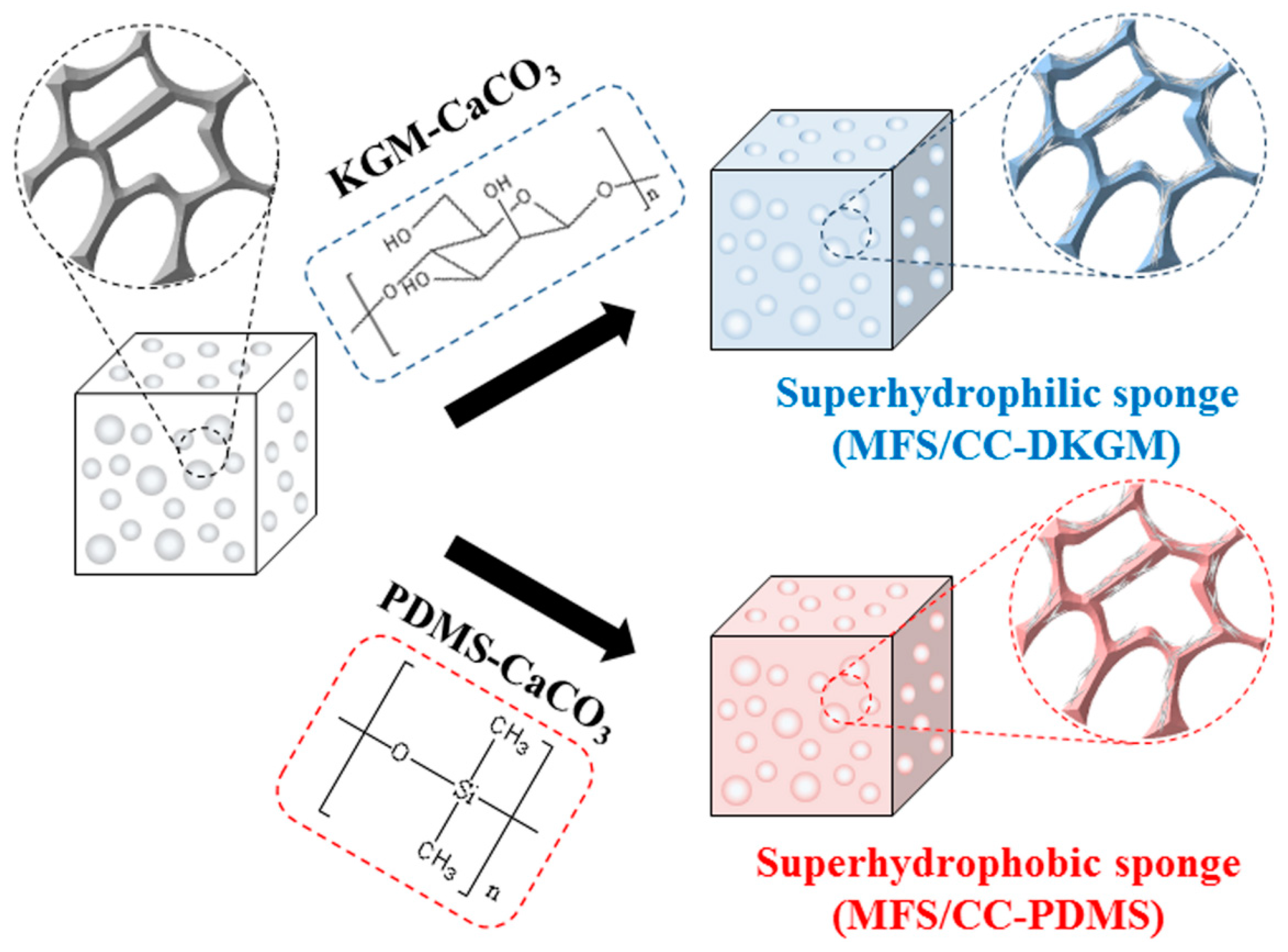
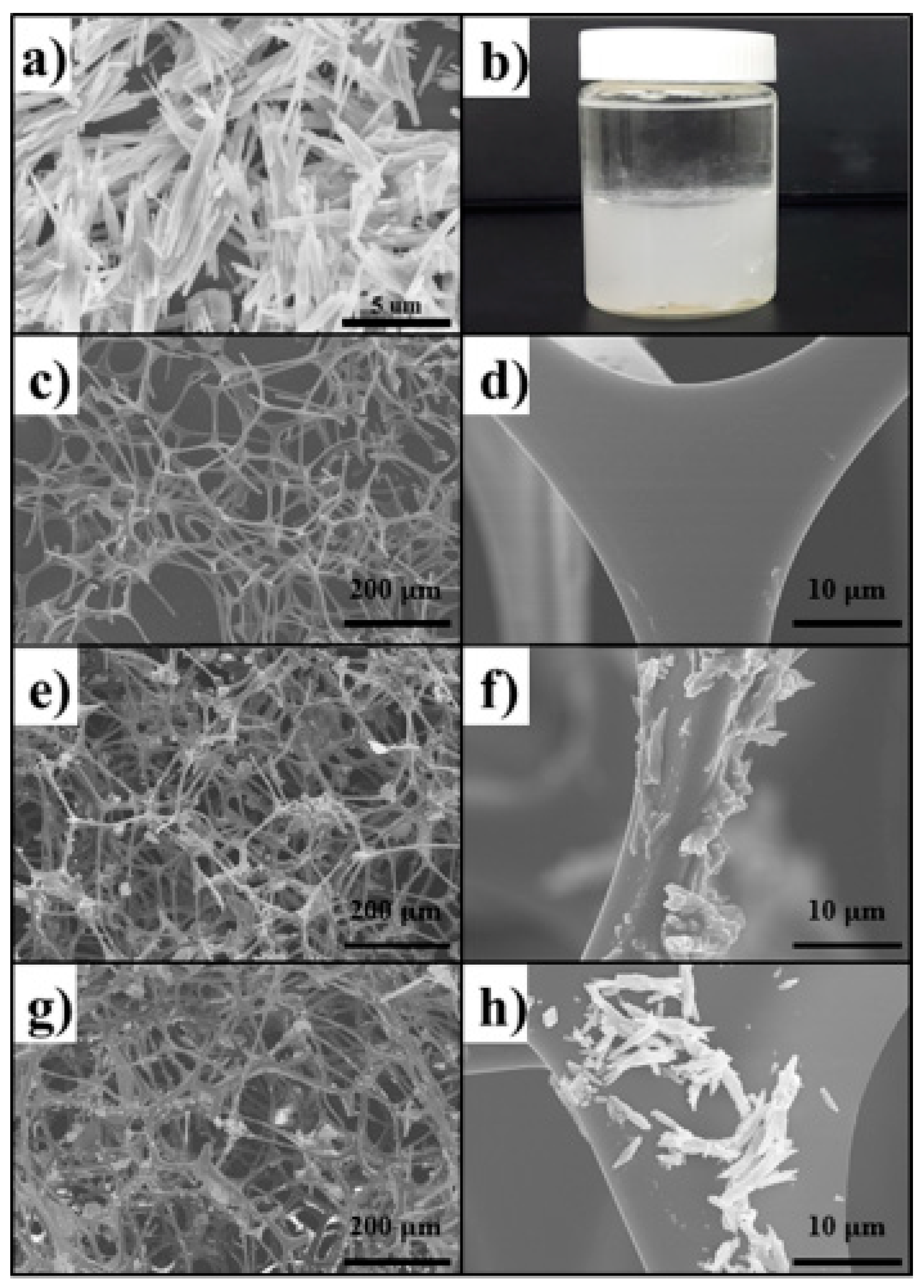
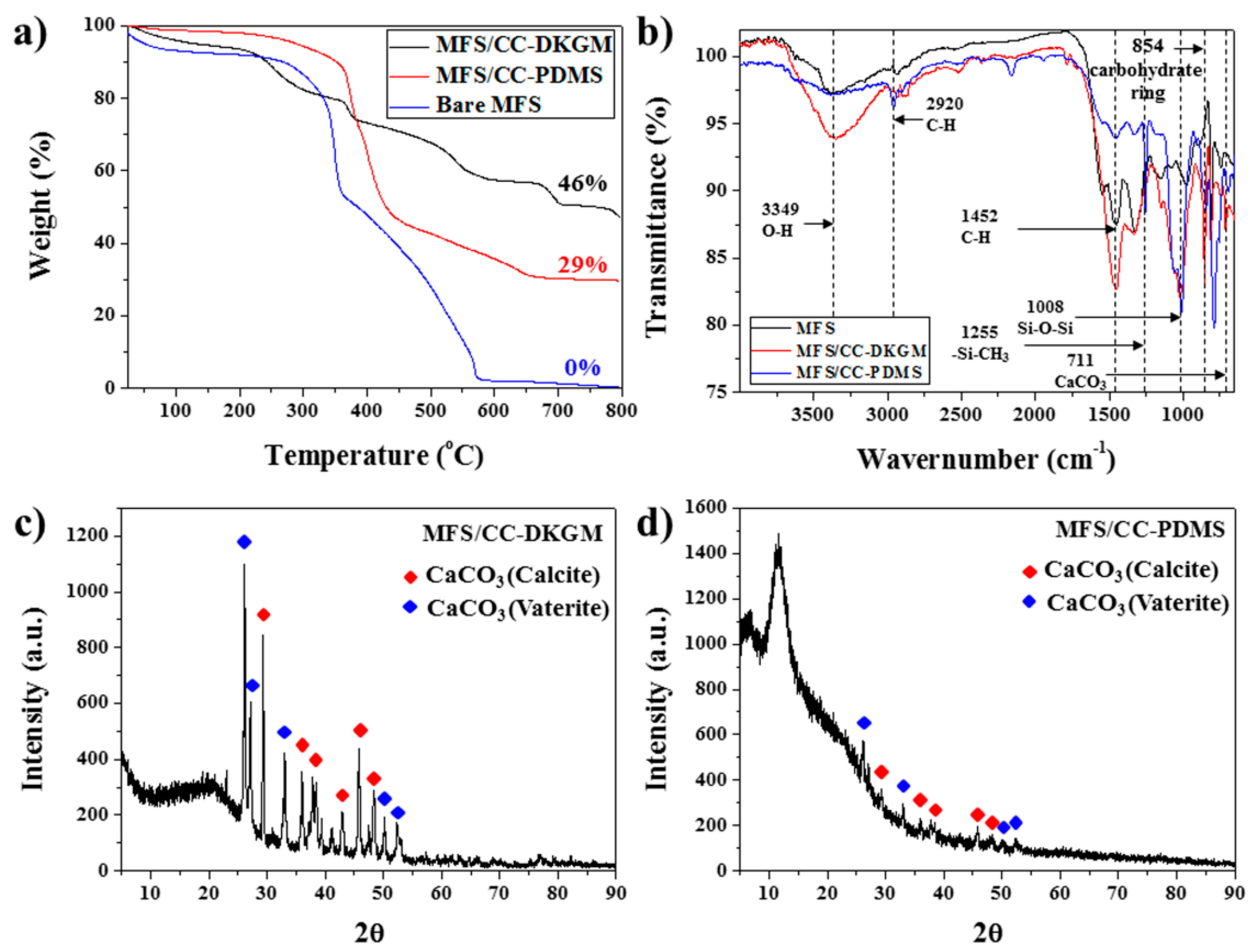
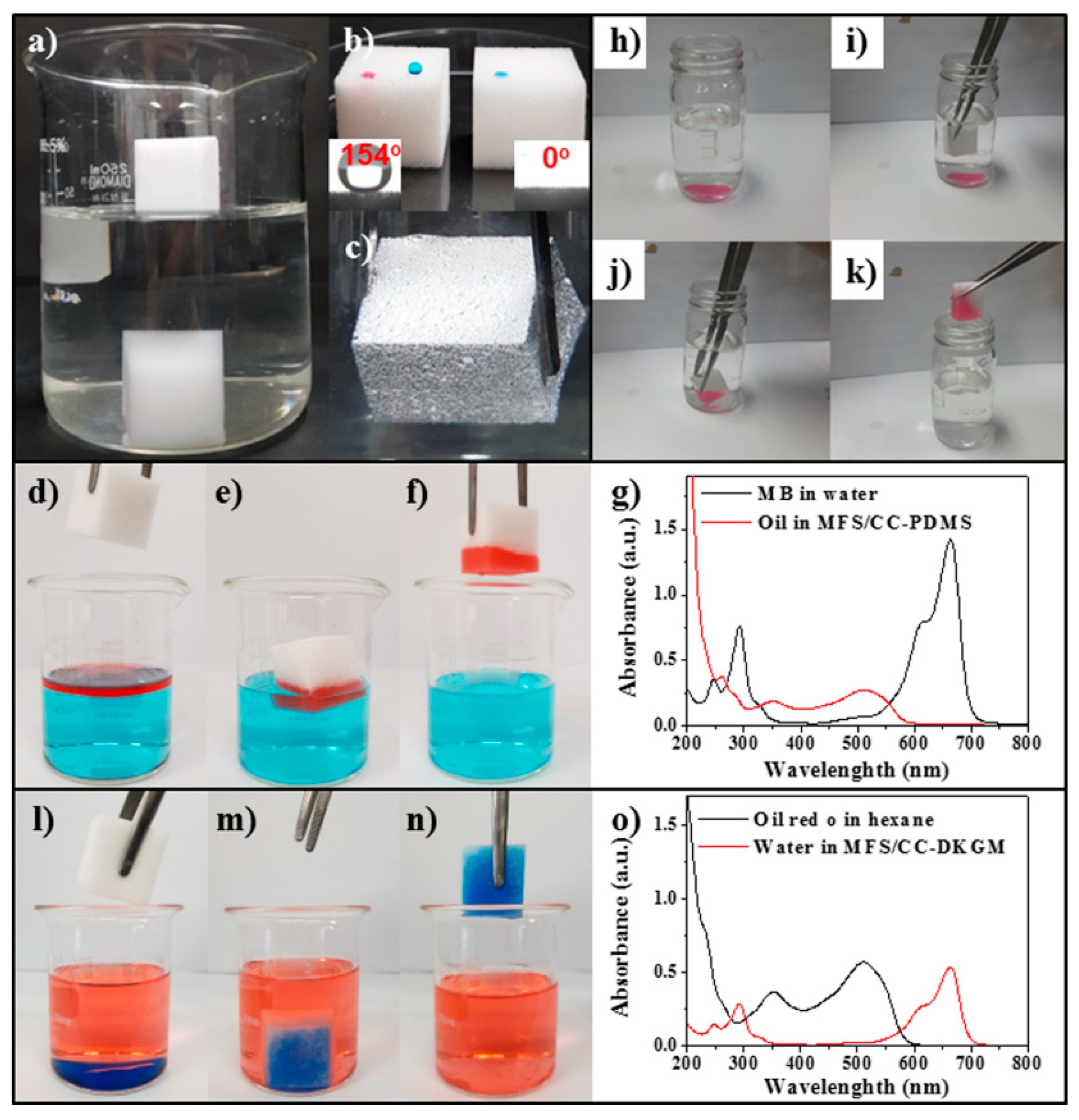
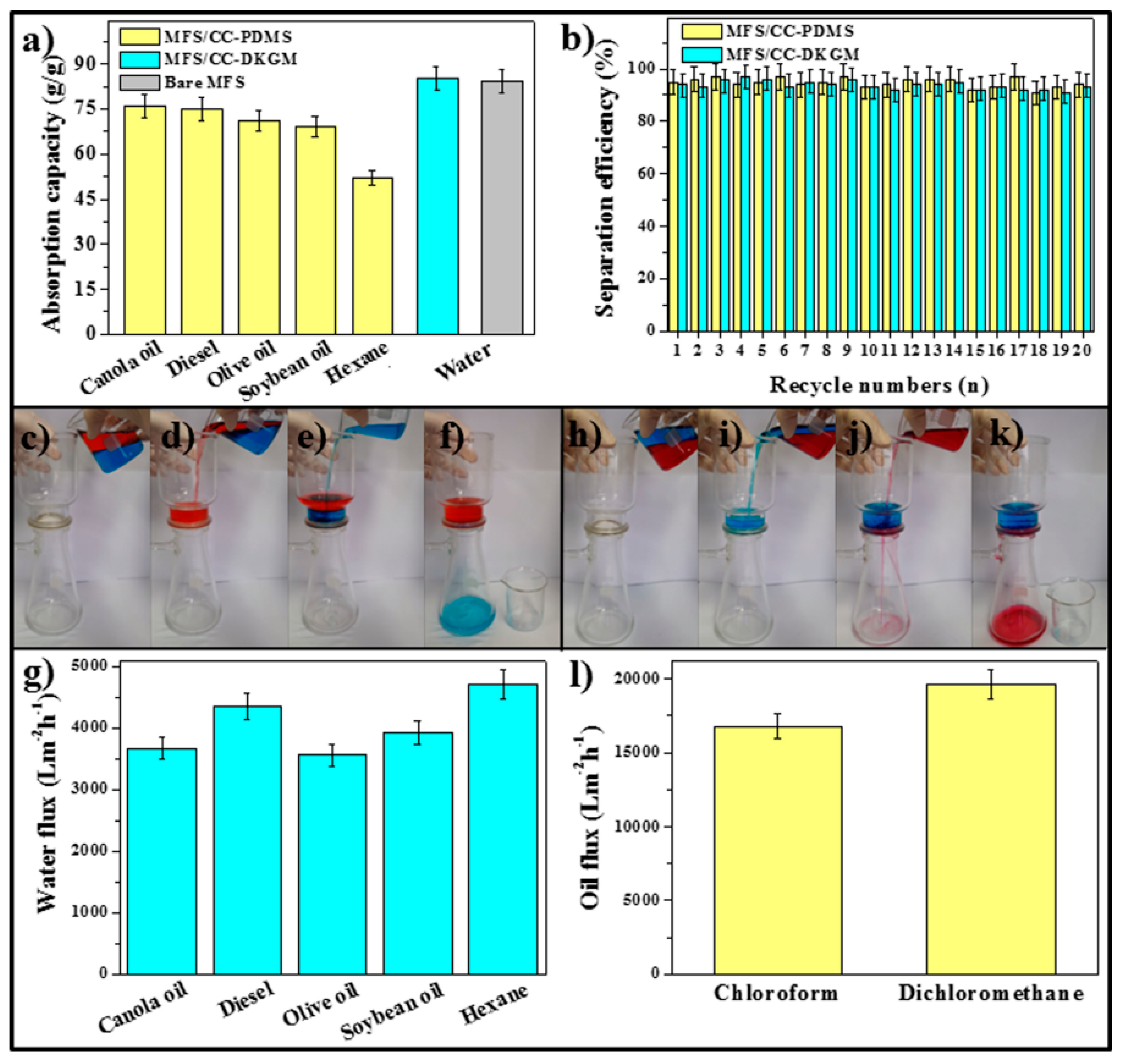

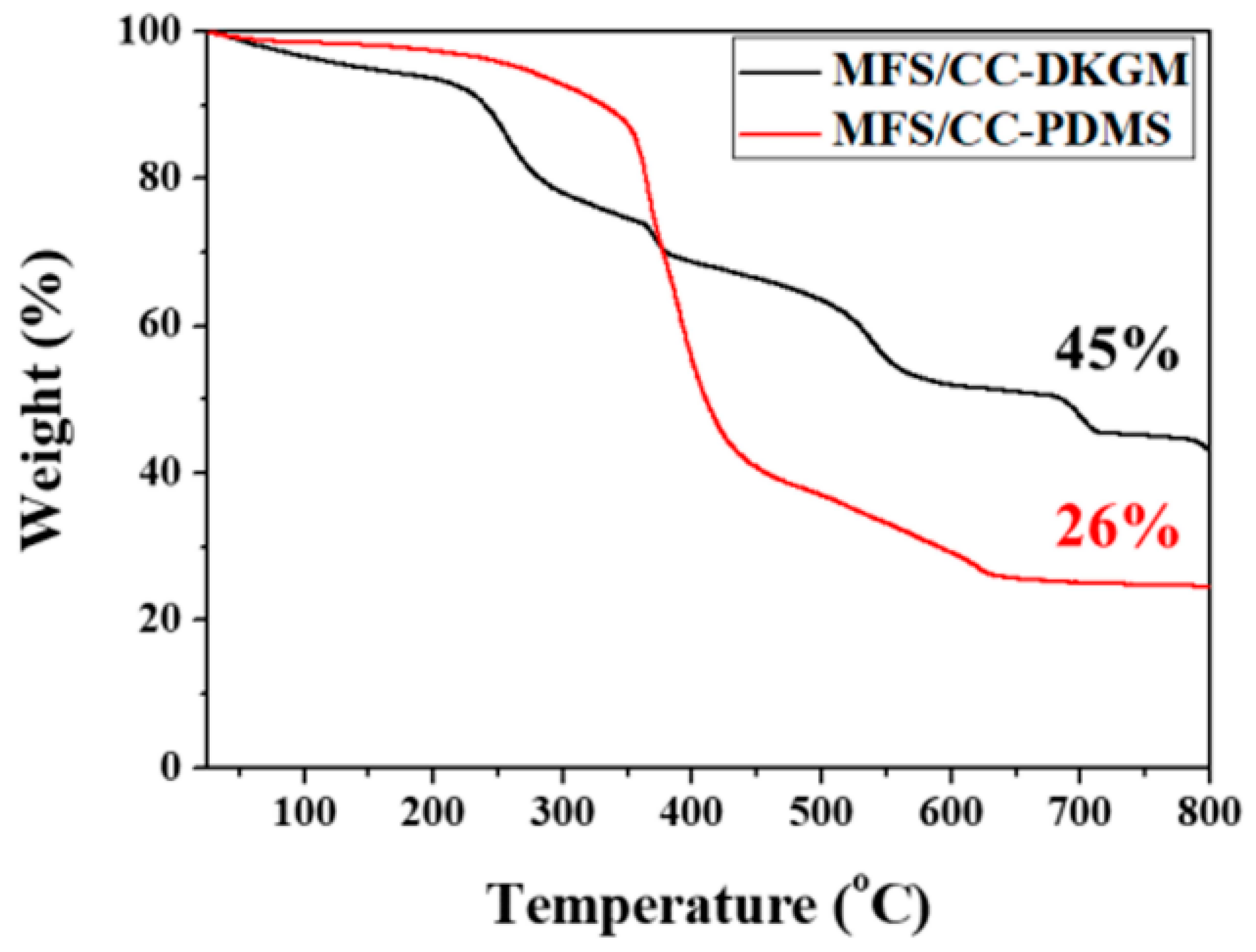
| Materials | Types of Liquid | Absorption Capacity (g/g) | Flux (L/m−2h−1) | Ref. |
|---|---|---|---|---|
| Hydrolyzed luffa sponge | Water | 75 | - | [32] |
| MFS/Fe3O4/CS-PFNA | Water | 65.7 | - | [33] |
| PUS/CNT/Pdop/ODA | n-Hexane | 34.9 | - | [34] |
| PUS/Graphene | n-Hexane | 29.5 | - | [35] |
| Cu mesh/Cement | Water/n-Hexane | - | 5000 (Water) | [36] |
| TiO2-PVDF membrane | Water/n-Hexane | - | 785 (Water) | [37] |
| Cellulose fiber/LDH | Water/Chloroform | - | 4968 (Chloroform) | [38] |
| SS mesh/Potato residue | Water/Chloroform | - | 32400 (Chloroform) | [39] |
| MFS/CC-DKGM | Water Water/n-Hexane | 85.2 - | - 4702 (Water) | This work |
| MFS/CC-PDMS | n-Hexane Water/Chloroform | 52 - | - 16793 (Chloroform) | This work |
© 2019 by the authors. Licensee MDPI, Basel, Switzerland. This article is an open access article distributed under the terms and conditions of the Creative Commons Attribution (CC BY) license (http://creativecommons.org/licenses/by/4.0/).
Share and Cite
Lee, Y.S.; Lim, Y.T.; Choi, W.S. One-Step Synthesis of Environmentally Friendly Superhydrophilic and Superhydrophobic Sponges for Oil/Water Separation. Materials 2019, 12, 1182. https://doi.org/10.3390/ma12071182
Lee YS, Lim YT, Choi WS. One-Step Synthesis of Environmentally Friendly Superhydrophilic and Superhydrophobic Sponges for Oil/Water Separation. Materials. 2019; 12(7):1182. https://doi.org/10.3390/ma12071182
Chicago/Turabian StyleLee, Yo Seph, Yong Taek Lim, and Won San Choi. 2019. "One-Step Synthesis of Environmentally Friendly Superhydrophilic and Superhydrophobic Sponges for Oil/Water Separation" Materials 12, no. 7: 1182. https://doi.org/10.3390/ma12071182
APA StyleLee, Y. S., Lim, Y. T., & Choi, W. S. (2019). One-Step Synthesis of Environmentally Friendly Superhydrophilic and Superhydrophobic Sponges for Oil/Water Separation. Materials, 12(7), 1182. https://doi.org/10.3390/ma12071182





